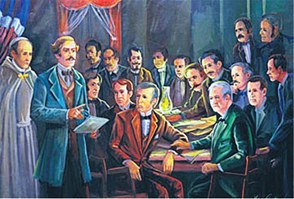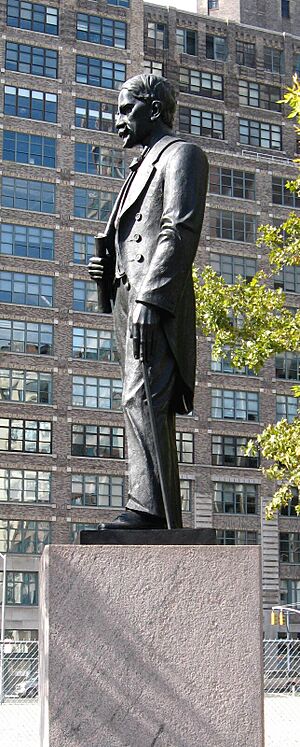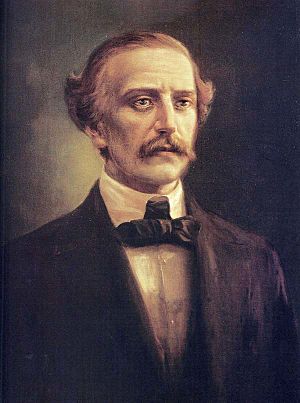Juan Pablo Duarte facts for kids
Juan Pablo Duarte (born January 26, 1813 – died July 15, 1877) was a very important leader from the Dominican Republic. He was a writer, an activist, and a strong believer in his country's freedom. Many people call him one of the main "founding fathers" of the Dominican Republic.
Duarte is seen as a hero and a visionary in the Dominican Republic today. He worked with military general Ramón Matías Mella and Francisco del Rosario Sánchez. Together, they created the Trinitario movement. This movement led to the Dominican revolt and their independence from Haiti in 1844. This event also started the Dominican War of Independence.
In 1842, Duarte became an officer in the National Guard. A year later, in 1843, he joined the "Reformist Revolution." This revolution was against the ruler Jean Pierre Boyer, who wanted to take over the whole island. After Boyer was defeated and the Dominican Republic became independent in 1844, a group chose Duarte to be the first leader. He was chosen by a large number of votes, but he said no. Instead, Tomás Bobadilla took the job.
Duarte helped to start and pay for the Dominican War of Independence. This cost him a lot of money and made him financially poor. He also strongly disagreed with people who wanted the country to rejoin the Spanish Empire. One of these people was a powerful military leader named Pedro Santana. Santana won these arguments, and Duarte had to live in exile. He lived in Venezuela until he passed away in 1877.
Contents
Early Life of Juan Pablo Duarte
Duarte was born on January 26, 1813, in Santo Domingo. This was during a time when the area was called España Boba. A friend of Duarte, José María Serra de Castro, wrote that Duarte had rosy skin, thin lips, blue eyes, and golden hair. This hair color was a strong contrast to his thick, dark mustache.
Duarte grew up in a middle-class family. They worked in sea trade and sold hardware in the port area of Santo Domingo. His father, Juan José Duarte Rodríguez, came from Spain. His mother, Manuela Díez Jiménez, was from El Seibo in Santo Domingo. Three of Duarte's grandparents were from Europe.
He had nine brothers and sisters. His oldest brother, Vicente Celestino Duarte (1802–1865), was a store owner and rancher. One of his sisters, Rosa Protomártir Duarte (1820–1888), was a performer. She also helped him a lot in the independence movement.
In 1802, the Duarte family moved from Santo Domingo to Mayagüez, Puerto Rico. They were trying to avoid the problems caused by the Haitian Revolution on the island. Many Dominican families left the island during this time. Toussaint Louverture, the governor of Saint-Domingue (now Haiti), had arrived in Santo Domingo the year before. He said that slavery was over, but these changes were not permanent.
At that time, France and Saint-Domingue were going through big social changes. These were the French Revolution and the Haitian Revolution. Louverture took over the Spanish side of the island. He used an agreement between France and Spain from 1795 as an excuse. This agreement, called the Peace of Basel, had given the Spanish area to France.
When Louverture arrived in Santo Domingo, he tried to end slavery there. However, slavery was fully ended in Santo Domingo only when Haiti took over again in 1822. Puerto Rico was still a Spanish colony. Mayagüez was very close to Hispaniola, just across the Mona Passage. It became a safe place for rich people from Santo Domingo, like the Duartes. These were people who did not want Haitian rule. Most experts believe that the Duartes' first son, Vicente Celestino, was born in Puerto Rico. The family returned to Santo Domingo in 1809. This was after Spain took back control of Santo Domingo.
In 1819, Duarte went to Manuel Aybar's school. There, he learned reading, writing, grammar, and math. He was also a student of Dr. Juan Vicente Moscoso. From him, Duarte learned Latin, philosophy, and law. This was because the university was closed by the Haitian leaders. After Dr. Moscoso was sent away to Cuba, a priest named Gaspar Hernández continued his teaching role.
The Fight for Dominican Independence

In December 1821, when Duarte was eight years old, a group of important people in Santo Domingo declared their independence from Spain. They called their new country Haití Español. Today, historians call this short period of freedom the Ephemeral Independence. The main leader of this change was José Núñez de Cáceres. These people were tired of being ignored by the Spanish king. Some were also worried about new liberal ideas in Spain.
This event was not the only one. The 1820s were a time of big political changes across the Spanish world. These changes directly affected middle-class families like the Duartes. It began with conflicts between Spanish royalists and liberals in Spain. This time is known as the Trienio Liberal. American patriots, like Simón Bolívar in South America, quickly used Spain's problems to fight against colonial troops. Even conservative leaders in New Spain (like Agustín de Iturbide in Mexico), who did not want to be ruled by anti-church Spanish leaders, decided to break away from Spain.
Many other people in Santo Domingo wanted independence from Spain for reasons closer to home. Inspired by the revolution on the island, Dominicans started different movements and secret plans. These were against slavery and colonial rule between 1809 and 1821. Several towns asked Haiti for help with Dominican independence. This happened weeks before the Haití Español experiment even began.
The government led by Cáceres asked for help from Simón Bolivar's new government. But their request was ignored because Gran Colombia had its own problems. Meanwhile, a plan to unite with Haiti grew stronger. Haitian politicians wanted to keep the island away from European powers. This was a way to protect the Haitian Revolution. Haiti's President Jean-Pierre Boyer sent an army that took over the eastern part of Hispaniola. Haiti then ended slavery there for good. Santo Domingo was occupied and became part of the Republic of Haiti.
Fights between Boyer and the old colonial leaders caused many plantation owners and important people to leave. It also led to the university closing. Following the custom of sending promising sons abroad for education, the Duartes sent Juan Pablo to the United States and Europe in 1828.

On July 16, 1838, Duarte and others created a secret group called La Trinitaria. This group helped to weaken Haitian rule. Some of its first members included Juan Isidro Pérez and Pedro Alejandro Pina. Later, Duarte and others started a group called La Filantrópica. This group was more public. It tried to spread ideas of freedom through plays and shows.
All of these efforts, along with help from many Dominicans who wanted to be free from Haitian rule, led to independence. The Dominican Republic declared its independence on February 27, 1844. However, Duarte had already been sent away to Caracas, Venezuela, the year before. This was because of his rebellious actions. He kept in touch with his family and other members of the independence movement.
Independence could not be stopped. After many struggles, the Dominican Republic was born. A republican government was set up. In this government, free people would have the power. Through voting, they would create a democracy where every citizen would be equal and free.
Many people supported Duarte as a candidate for president of the new country. Mella wanted Duarte to simply declare himself president. But Duarte never gave up on his beliefs in democracy and fairness. He would only accept the presidency if the Dominican people voted him in.
Duarte had a clear idea of what the Dominican nation and its people should be. He believed in a republic that was anti-colonial, liberal, and progressive. He wrote a draft constitution that clearly stated the Dominican flag could welcome all races. It would not exclude or favor any one group.
However, forces led by General Pedro Santana took over. Santana was a rich landowner who wanted Spanish rule to protect the country from Haitian threats. Santana sent Duarte away. In 1845, Santana exiled Duarte's entire family. After more Haitian invasions, problems inside the country, and his own bad rule, Santana made the country a colony of Spain again in 1861. He was given the title of Marquess of Las Carreras by the Spanish Queen Isabella II. Santana died in 1864.
Duarte's family in Venezuela did well. They lived and worked in a wealthy area. Duarte's cousin, Manuel Diez, became Vice President of Venezuela. He helped to protect Duarte. Duarte's family was known for making candles. This was a big business because light bulbs had not been invented yet. So, the Duartes had a good income.
Juan Pablo was a man of action and very curious. He traveled around Venezuela. He met with contacts he had there. Venezuela at this time was having many civil wars and internal problems. Even though he and his family lived there, Duarte did not want to openly join the country's political life. This was true even though his cousin, Manuel Antonio Díez, became President of Venezuela for a short time.
Duarte's travels in Venezuela involved studying the local people. He learned from black and mixed-race communities. He also observed as much as he could about Venezuela at that time. Duarte was a very educated man. He spoke many languages and was a former soldier and teacher. These skills helped him survive and do well in the places he visited.
However, he was probably seen as an outsider. Since he came from a Caribbean country, he likely sounded different from most Spanish speakers around him. But Santo Domingo and the Republic he helped create were always close to his heart. He was a man divided. He was excited by his surroundings, people, and events in Venezuela. But he was also always thinking about his beloved homeland and the people he sacrificed so much for. A man who had been hurt by such a harsh exile would have little time for a long-term wife, children, or a stable life.
Duarte, living in Venezuela, was made the Dominican Consul. He was given a pension to honor him for his sacrifices. But after some time, this honor and pension were taken away. Juan Pablo Duarte, the poet, philosopher, writer, actor, soldier, general, dreamer, and hero, died nobly in Caracas at 63 years old. His body was brought back to the Dominican Republic in 1884. This was done by president and dictator Ulises Heureaux. Duarte was given a proper burial with full honors. He is buried in a beautiful tomb, the Altar de la Patria, at the Count's Gate (Puerta del Conde). He rests there alongside Sanchez and Mella, who fired the famous rifle shot at that spot.
Honoring Juan Pablo Duarte
- Dominicans celebrate Duarte's birthday every January 26.
- There is a memorial to Duarte in Roger Williams Park in Providence, Rhode Island.
- Broad St. in Providence, Rhode Island, is also named Juan Pablo Duarte Boulevard.
- A bronze statue of Duarte was put up in New York City in 1978. It is at the corner of 6th Avenue and Canal Street.
- St. Nicholas Avenue in Manhattan is also called Juan Pablo Duarte Boulevard. This part runs from Amsterdam Avenue and West 162nd Street to West 193rd Street and Fort George Hill.
- The Puente Juan Pablo Duarte is a suspension bridge in Santo Domingo. It was named after him.
See also
 In Spanish: Juan Pablo Duarte para niños
In Spanish: Juan Pablo Duarte para niños





